Incremental Growth Analysis of a Cantilever Beam under Cyclic Thermal and Axial Loads
Abstract
1. Introduction
2. Methodology
2.1. Solution for Stresses and Strains
- Purely elastic regime (E);
- Shakedown regime one (S1);
- Shakedown regime two (S2);
- Plastic cyclic regime (P);
- Ratcheting regime one (R1);
- Ratcheting regime two (R2).
2.2. Material Behavior Assumptions
2.3. Problem Definition
2.4. The Study Procedure
3. Results and Discussion
- Its remarkable capability to examine the critical design parameters prior to the construction process reduces potential costs.
- Its virtual prototyping capability allows the design process to be conducted with the fewest physical prototypes. Consequently, companies are less likely to spend such huge amounts of money on unsuccessful experiments.
- This analysis considers various conditions and characteristics (stress, fatigue, creep, ratcheting, shakedown, etc.) for the prototypes.
- By exploiting FEA, we will have high productivity levels in manufacturing, and the industries will considerably prosper.
4. Conclusions
- For Regime R1, the plastic strain in the first applying thermal load equals the sum of the elastic and plastic strain of the applied load in the following cycles, as shown in Figure 5.
- As shown in Figure 5, the difference between the maximum and minimum stress related to a cyclic thermal load and the initial stress due to constant load in Regime R1 is equal.
- In contrast to the results of Regime R1, the absolute values of maximum and minimum stress are the same in Regime R2, as presented in Figure 6.
- Fully reversed plastic does not occur in Regime R2. When applying the thermal load, the plastic strain is larger than the plastic strain when removing the thermal load, whereas there is no plastic strain when removing the load in Regime R1.
- Low-cycle fatigue is found in Regime P, as shown in Figure 7.
- All of the regimes with more cycles could also be observed, as shown in Figure 10.
- Figure 11 shows that various amounts could be obtained from Bree’s diagram to reach the regimes (elastic, shakedown, fully plastic, and ratcheting).
- Theoretical results were compared to results obtained by FEM, and it turned out that there is a good agreement between them, as shown in Figure 13.
- Based on the striking benefits of finite element analysis, exploiting this solution is recommended.
Author Contributions
Funding
Institutional Review Board Statement
Informed Consent Statement
Data Availability Statement
Acknowledgments
Conflicts of Interest
References
- Govindarajan, S.; Sundararajan, V. Elasto-plastic behaviour of a thin cylinder under thermal stress cycling. Nucl. Eng. Des. 1983, 75, 87–98. [Google Scholar] [CrossRef]
- Hyde, T.; Sahari, B.; Webster, J. The effect of axial loading and axial restraint on the thermal ratchetting of thin tubes. Int. J. Mech. Sci. 1985, 27, 679–692. [Google Scholar] [CrossRef]
- Hyde, T.; Sahari, B.; Webster, J. Thermal ratchetting of a tube with non-uniform thickness. Int. J. Mech. Sci. 1986, 28, 657–670. [Google Scholar] [CrossRef]
- Updike, D. Thermal ratcheting under biaxial stress states. Nucl. Eng. Des. 1975, 33, 387–397. [Google Scholar] [CrossRef]
- Gao, B.; Chen, X.; Chen, G. Ratchetting and ratchetting boundary study of pressurized straight low carbon steel pipe under reversed bending. Int. J. Press. Vessel. Pip. 2006, 83, 96–106. [Google Scholar] [CrossRef]
- Shariati, M.; Hatami, H.; Yarahmadi, H.; Eipakchi, H.R. An experimental study on the ratcheting and fatigue behavior of polyacetal under uniaxial cyclic loading. Mater. Des. 2012, 34, 302–312. [Google Scholar] [CrossRef]
- Zhu, S.P.; Lei, Q.; Wang, Q.Y. Mean stress and ratcheting corrections in fatigue life prediction of metals. Fatigue Fract. Eng. Mater. Struct. 2017, 40, 1343–1354. [Google Scholar] [CrossRef]
- Carter, P. Analysis of cyclic creep and rupture. Part 2: Calculation of cyclic reference stresses and ratcheting interaction diagrams. Int. J. Press. Vessel. Pip. 2005, 82, 27–33. [Google Scholar] [CrossRef]
- Vu, D.K.; Staat, M. Shakedown analysis of structures made of materials with temperature-dependent yield stress. Int. J. Solids Struct. 2007, 44, 4524–4540. [Google Scholar] [CrossRef][Green Version]
- Shahrjerdi, A.; Souq, S.H.F. The ratcheting effect on the SS316L U-shaped pipe under internal pressure and bending cycle. Int. J. Press. Vessel. Pip. 2023, 205, 104971. [Google Scholar] [CrossRef]
- Shahrjerdi, A.; SafariFard, A. The numerical and experimental analysis of ratcheting behavior for 304 steel sheets under cyclic axial loading. Adv. Mech. Eng. 2023, 15, 16878132231168277. [Google Scholar] [CrossRef]
- Shahrjerdi, A.; Heydari, H.; Bayat, M. Bree’s diagram for functionally graded beam under cyclic thermal and axial loads. J. Braz. Soc. Mech. Sci. Eng. 2023, 45, 11. [Google Scholar] [CrossRef]
- Kolasangiani, K.; Shariati, M. Experimental study of SS304L cylindrical shell with/without cutout under cyclic combined and uniaxial loading. Int. J. Steel Struct. 2017, 17, 553–563. [Google Scholar] [CrossRef]
- Bree, J. Plastic deformation of a closed tube due to interaction of pressure stresses and cyclic thermal stresses. Int. J. Mech. Sci. 1989, 31, 865–892. [Google Scholar] [CrossRef]
- Lee, H.-Y.; Kim, J.-B.; Lee, J.-H. Thermal ratchetting deformation of a 316L stainless steel cylindrical structure under an axial moving temperature distribution. Int. J. Press. Vessel. Pip. 2003, 80, 41–48. [Google Scholar] [CrossRef]
- Chinh, P.D. Shakedown of bars subjected to cycles of loads and temperature. Int. J. Solids Struct. 1993, 30, 1173–1179. [Google Scholar] [CrossRef]
- Megahed, M. Influence of hardening rule on the elasto-plastic behaviour of a simple structure under cyclic loading. Int. J. Mech. Sci. 1981, 23, 169–182. [Google Scholar] [CrossRef]
- Parkes, E.W. Structural effects of repeated thermal loading. In Thermal Stress; Benham, P.P., Hoyle, R., Eds.; Pitman: London, UK, 1964. [Google Scholar]
- Adibi-Asl, R.; Reinhardt, W. Ratcheting with No Thermal Bending and Membrane Stress. In Proceedings of the ASME 2016 Pressure Vessels and Piping Conference, American Society of Mechanical Engineers Digital Collection, Vancouver, BC, Canada, 17–21 July 2016. [Google Scholar]
- Crisan, A.; Dubina, D. Bending–shear interaction in short coupling steel beams with reduced beam section. J. Constr. Steel Res. 2016, 122, 190–197. [Google Scholar] [CrossRef]
- Hübel, H.; Vollrath, B. Ratcheting caused by moving loads. Int. J. Adv. Struct. Eng. 2017, 9, 139–152. [Google Scholar] [CrossRef]
- Abdollahi, E.; Chakherlou, T.N. Numerical and experimental study of ratcheting in cold expanded plate of Al-alloy 2024-T 3 in double shear lap joints. Fatigue Fract. Eng. Mater. Struct. 2018, 41, 41–56. [Google Scholar] [CrossRef]
- Ghosh, A.; Gurao, N. Effect of crystallographic texture on ratcheting response of commercially pure titanium. Mater. Des. 2017, 115, 121–132. [Google Scholar] [CrossRef]
- Kolasangiani, K.; Shariati, M.; Farhangdoost, K.; Varvani-Farahani, A. Numerical and Experimental Study on Ratcheting Behavior of Plates with Circular Cutouts under Cyclic Axial Loading. J. Solid Mech. 2017, 9, 811–820. [Google Scholar]
- Shahraini, S.I.; Kadkhodayan, M. A new numerical method for elastic-plastic plate analysis: Theoretical-experimental validation and its application in ratcheting phenomenon. Eng. Anal. Bound. Elem. 2023, 154, 64–82. [Google Scholar] [CrossRef]
- Servatan, M.; Hashemi, S.; Varvani-Farahani, A. Ratcheting assessment of additively manufactured alloys through the hardening framework: Analysis and simulation. Mater. Today Commun. 2023, 35, 105916. [Google Scholar] [CrossRef]
- Yu, B.; Li, Y.; Abbès, B.; Li, S.; Yu, B. Experimental and numerical study of the compressive fatigue behavior of a Ti6Al4V mapped rhombioidal dodecahedral structure fabricated by electron beam melting. Int. J. Fatigue 2023, 177, 107912. [Google Scholar] [CrossRef]
- Shyamala, G.; Hemalatha, B.; Devarajan, Y.; Lakshmi, C.; Munuswamy, D.B.; Kaliappan, N. Experimental investigation on the effect of nano-silica on reinforced concrete Beam-column connection subjected to Cyclic Loading. Sci. Rep. 2023, 13, 17392. [Google Scholar] [CrossRef]
- Li, H.; Chen, H.; Xu, Y.; Shen, J. Flexural behaviors of concrete beams under monotonic and cyclic loadings. Constr. Build. Mater. 2023, 362, 129721. [Google Scholar] [CrossRef]
- Bree, J. Elastic-plastic behaviour of thin tubes subjected to internal pressure and intermittent high-heat fluxes with application to fast-nuclear-reactor fuel elements. J. Strain Anal. 1967, 2, 226–238. [Google Scholar] [CrossRef]
- Abdalla, H.F. Effect of wall thinning on the Shakedown Interaction Diagrams of 90-degree back-to-Back Bends Subjected to Simultaneous Steady Internal Pressures and Cyclic In Plane Bending Moments. Thin-Walled Struct. 2019, 144, 106228. [Google Scholar] [CrossRef]
- Auricchio, F.; Constantinescu, A.; Menna, C.; Scalet, G. A shakedown analysis of high cycle fatigue of shape memory alloys. Int. J. Fatigue 2016, 87, 112–123. [Google Scholar] [CrossRef]
- Giugliano, D.; Chen, H. Micromechanical modeling on cyclic plastic behavior of unidirectional fiber reinforced aluminum matrix composites. Eur. J. Mech. A/Solids 2016, 59, 155–164. [Google Scholar] [CrossRef]
- Spagnoli, A.; Terzano, M.; Barber, J.; Klarbring, A. Non-linear programming in shakedown analysis with plasticity and friction. J. Mech. Phys. Solids 2017, 104, 71–83. [Google Scholar] [CrossRef]
- Hübel, H.; Vollrath, B. Simplified Analysis of Strains Accumulated in the State of Elastic Shakedown Considering Multi-Parameter Loadings. In Proceedings of the ASME 2018 Pressure Vessels and Piping Conference, American Society of Mechanical Engineers Digital Collection, Prague, Czech Republic, 15–20 July 2018. [Google Scholar]
- Šeruga, D.; Nagode, M. A new approach to finite element modelling of cyclic thermomechanical stress-strain responses. Int. J. Mech. Sci. 2019, 164, 105139. [Google Scholar] [CrossRef]
- Yuan, X.; Fu, S.; Yu, D.; Yu, W.; Chen, X. Temperature-dependent bending ratcheting behavior of a 316LN stainless steel. J. Mater. Eng. Perform. 2016, 25, 274–279. [Google Scholar] [CrossRef]
- Gong, J.-G.; Niu, T.-Y.; Chen, H.; Xuan, F.-Z. Shakedown analysis of pressure pipeline with an oblique nozzle at elevated temperatures using the linear matching method. Int. J. Press. Vessel. Pip. 2018, 159, 55–66. [Google Scholar] [CrossRef]
- Peng, H.; Liu, Y.; Chen, H. Shakedown analysis of elastic-plastic structures considering the effect of temperature on yield strength: Theory, method and applications. Eur. J. Mech. A/Solids 2019, 73, 318–330. [Google Scholar] [CrossRef]
- Agius, D.; Kajtaz, M.; Kourousis, K.I.; Wallbrink, C.; Wang, C.H.; Hu, W.; Silva, J. Sensitivity and optimisation of the Chaboche plasticity model parameters in strain-life fatigue predictions. Mater. Des. 2017, 118, 107–121. [Google Scholar] [CrossRef]
- Houlsby, G.; Abadie, C.; Beuckelaers, W.; Byrne, B. A model for nonlinear hysteretic and ratcheting behaviour. Int. J. Solids Struct. 2017, 120, 67–80. [Google Scholar] [CrossRef]
- Kolasangiani, K.; Shariati, M.; Farhangdoost, K.; Varvani-Farahani, A. Ratcheting progress at notch root of 1045 steel samples over asymmetric loading cycles: Experiments and analyses. Fatigue Fract. Eng. Mater. Struct. 2018, 41, 1870–1883. [Google Scholar] [CrossRef]
- Chen, X.; Jiao, R. Modified kinematic hardening rule for multiaxial ratcheting prediction. Int. J. Plast. 2004, 20, 871–898. [Google Scholar] [CrossRef]
- Chen, X.; Jiao, R.; Kim, K.S. On the Ohno–Wang kinematic hardening rules for multiaxial ratcheting modeling of medium carbon steel. Int. J. Plast. 2005, 21, 161–184. [Google Scholar] [CrossRef]
- Abdel-Karim, M. An evaluation for several kinematic hardening rules on prediction of multiaxial stress-controlled ratchetting. Int. J. Plast. 2010, 26, 711–730. [Google Scholar] [CrossRef]
- Hassan, T.; Kyriakides, S. Ratcheting in cyclic plasticity, part I: Uniaxial behavior. Int. J. Plast. 1992, 8, 91–116. [Google Scholar] [CrossRef]
- Ponter, A.; Leckie, F. On the behaviour of metal matrix composites subjected to cyclic thermal loading. J. Mech. Phys. Solids 1998, 46, 2183–2199. [Google Scholar] [CrossRef]
- Portier, L.; Calloch, S.; Marquis, D.; Geyer, P. Ratchetting under tension–torsion loadings: Experiments and modelling. Int. J. Plast. 2000, 16, 303–335. [Google Scholar] [CrossRef]
- Megahed, M. Influence of hardening rule on prediction of cyclic plasticity in pressurized thin tubes subjected to cyclic push-pull. Int. J. Mech. Sci. 1990, 32, 635–652. [Google Scholar] [CrossRef]
- Webster, J.; Hardy, S.; Hyde, T. Inelastic behaviour of rectangular beams subjected to steady axial load and cyclic bending. Int. J. Mech. Sci. 1985, 27, 257–271. [Google Scholar] [CrossRef]
- Adibi-Asl, R.; Reinhardt, W. Non-cyclic shakedown/ratcheting boundary determination–Part 1: Analytical approach. Int. J. Press. Vessel. Pip. 2011, 88, 311–320. [Google Scholar] [CrossRef]
- Zeinoddini, M.; Mo’tamedi, M.; Gharebaghi, S.A.; Parke, G. On the ratcheting response of circular steel pipes subject to cyclic inelastic bending: A closed-form analytical solution. Int. J. Mech. Sci. 2016, 117, 243–257. [Google Scholar] [CrossRef]
- Zheng, X.; Peng, H.; Yu, J.; Wang, W.; Lin, W.; Xu, J. Analytical ratchet limit for pressurized pipeline under cyclic nonproportional loadings. J. Pipeline Syst. Eng. Pract. 2017, 8, 04017002. [Google Scholar] [CrossRef]
- Bocklet, M.; Ahmadi, F.; Tremont, T.; Ross, L.; Yao, H.; Andrade, I., Jr. Comparison of 3D-printed and laboratory-fabricated Hyrax on stress distribution and displacement of the maxillary complex: A 3D finite element study. Prog. Orthod. 2024, 25, 11. [Google Scholar] [CrossRef] [PubMed]
- Igari, T.; Wada, H.; Ueta, M. Mechanism-based evaluation of thermal ratcheting due to traveling temperature distribution. J. Press. Vessel Technol. 2000, 122, 130–138. [Google Scholar] [CrossRef]
- Scholz, C.; D’silva, S.; Pöschel, T. Ratcheting and tumbling motion of Vibrots. New J. Phys. 2016, 18, 123001. [Google Scholar] [CrossRef]
- Sinha, S.; Ghosh, S. Modeling cyclic ratcheting based fatigue life of HSLA steels using crystal plasticity FEM simulations and experiments. Int. J. Fatigue 2006, 28, 1690–1704. [Google Scholar] [CrossRef]
- Halama, R.; Fusek, M.; Poruba, Z. Influence of mean stress and stress amplitude on uniaxial and biaxial ratcheting of ST52 steel and its prediction by the AbdelKarim–Ohno model. Int. J. Fatigue 2016, 91, 313–321. [Google Scholar] [CrossRef]
- Karami, S.; Piroozi, B.; Borhani, E. Fatigue-induced microstructure evolution and ratcheting behavior of ultrafine-grained (UFG) pure aluminum processed by accumulative roll bonding (ARB). Mater. Charact. 2023, 196, 112578. [Google Scholar] [CrossRef]
- Bahadur, F.; Sadhasivam, M.; Pradeep, K.; Gurao, N.; Biswas, K. Ratcheting behavior of non-equiatomic TRIP dual-phase high entropy alloy. Materialia 2022, 24, 101512. [Google Scholar] [CrossRef]
- Tasavori, M.; Zehsaz, M.; Tahami, F.V. Ratcheting assessment in the tubesheets of heat exchangers using the nonlinear isotropic/kinematic hardening model. Int. J. Press. Vessel. Pip. 2020, 183, 104103. [Google Scholar] [CrossRef]
- Zhang, Z.; Yue, Z.; Bao, Y.; Gao, J. Ratcheting characterization and its effect on low cycle fatigue behavior of DP600 steel sheet under cyclic shear path. Int. J. Fatigue 2023, 166, 107231. [Google Scholar] [CrossRef]
- Muscat, M.; Hamilton, R.; Boyle, J.T. Shakedown analysis for Complex loading using superposition. J. Strain. Anal. 2002, 37, 399–411. [Google Scholar] [CrossRef]
- Mrzyglod, M.; Zielinski, A. Multiaxial high-cycle fatigue constraints in structural optimization. Int. J. Fatigue 2007, 29, 1920–1926. [Google Scholar] [CrossRef]
- Vlaicu, D. Shakedown analysis of nuclear components using linear and nonlinear methods. J. Press. Vessel Technol. 2010, 132, 021203. [Google Scholar] [CrossRef]
- Vu, Q.H.; Vu, D.Q. Implementation of multiaxial high cycle fatigue criterion in finite element analysis. MATEC Web Conf. 2016, 77, 01022. [Google Scholar] [CrossRef]
- Halama, R.; Gál, P.; Paška, Z.; Sedlák, J. A new accelerated technique for validation of cyclic plasticity models. MATEC Web Conf. 2018, 157, 05008. [Google Scholar] [CrossRef][Green Version]
- Wei, X.; Zhou, H.; Kamaris, G.S.; Gkantou, M.; Yun, F.; Zuo, X.; Guo, X.; Bin Ali, S. Cyclic behaviour of welded stainless steel beam-to-column connections: Experimental and numerical study. J. Constr. Steel Res. 2024, 218, 108736. [Google Scholar] [CrossRef]
- Chen, L.; Qiang, X.; Jiang, X.; Bai, J. Numerical study of steel–concrete composite beams strengthened by CFRP plates with prestressed unbonded reinforcement system. Eng. Fail. Anal. 2024, 157, 107905. [Google Scholar] [CrossRef]
- Wang, W.; Zhang, C.; Zhang, Z.; Li, L.; Wei, J. Experimental and numerical simulation study on flexural performance of high-strength reinforced concrete beams under static loading. Structures 2024, 63, 106482. [Google Scholar] [CrossRef]
- Le, K.B.; Van Cao, V. Performance of circular concrete-filled steel tube beams under monotonic and cyclic loadings. J. Constr. Steel Res. 2024, 212, 108301. [Google Scholar] [CrossRef]
- Mussa, M.H.; Mutalib, A.A.; Hao, H. Experimental and Numerical Study of Carbon Fibre-Reinforced Polymer-Strengthened Reinforced Concrete Beams under Static and Impact Loads. Fibers 2024, 12, 63. [Google Scholar] [CrossRef]
- Merzouki, T.; Houari, M.S.A. Nonlocal Strain Gradient Theory for Free Vibration Analysis of FG Nano-scale Beams in Thermal Environments Using an Efficient Numerical Model. J. Vib. Eng. Technol. 2024, 12, 1–26. [Google Scholar]
- Hyde, A.F.L.; Ward, S.J. A pore pressure and stability model for a silty clay under repeated loading. Geotechnique 1985, 35, 113–125. [Google Scholar] [CrossRef]
- Chakraborty, A.; Gopalakrishnan, S.; Reddy, J. A new beam finite element for the analysis of functionally graded materials. Int. J. Mech. Sci. 2003, 45, 519–539. [Google Scholar] [CrossRef]
- Papadakis, N.; Condaxakis, C. An Experimental Performance Assessment of a Passively Controlled Wind Turbine Blade Concept: Part A—Isotropic Materials. Energies 2024, 17, 3049. Available online: https://www.mdpi.com/1996-1073/17/12/3049 (accessed on 20 June 2024). [CrossRef]
- Arnaoutakis, G.E.; Katsaprakakis, D.A. Energy Performance of Buildings with Thermochromic Windows in Mediterranean Climates. Energies 2021, 14, 6977. Available online: https://www.mdpi.com/1996-1073/14/21/6977 (accessed on 25 October 2021). [CrossRef]
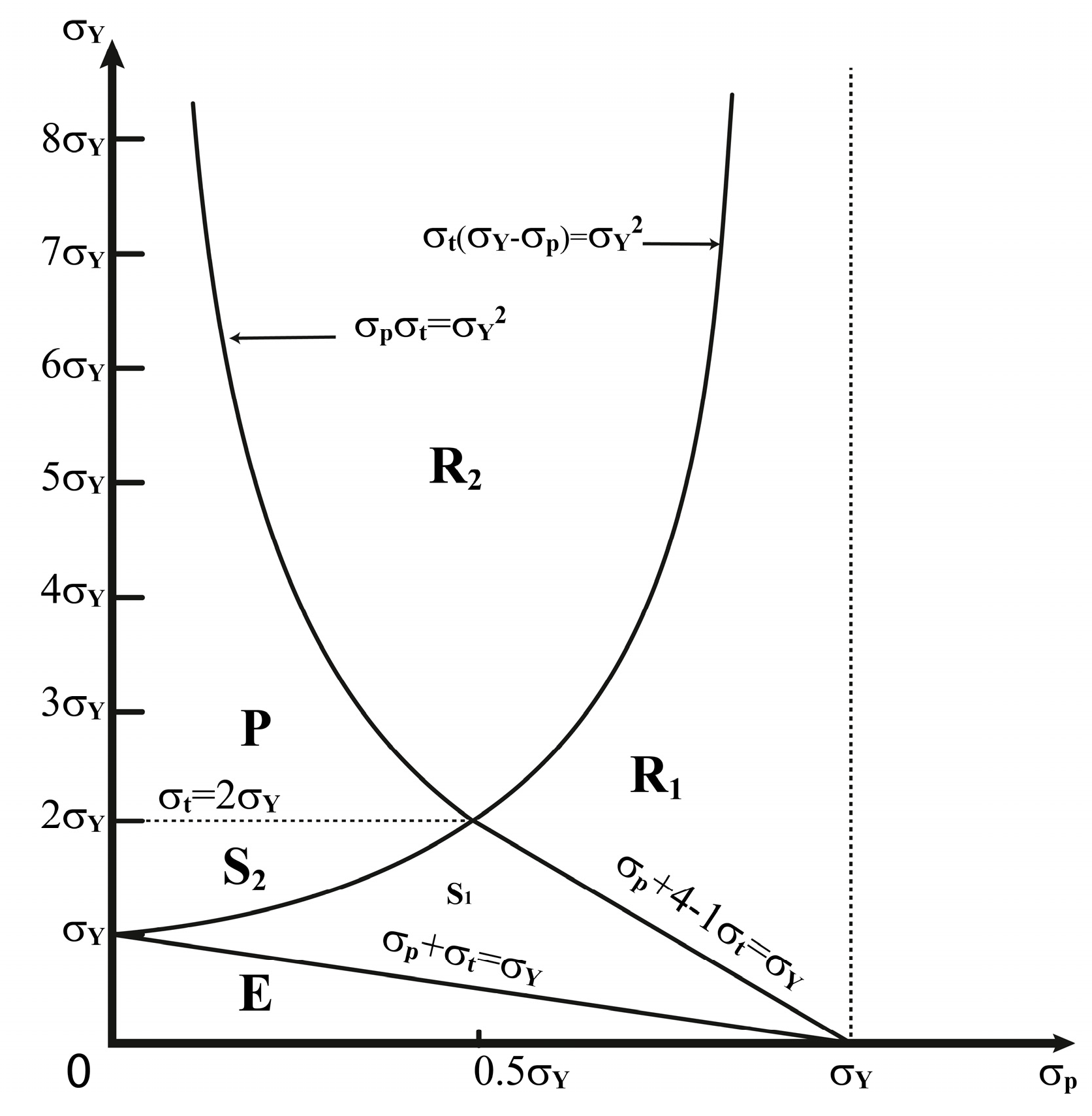

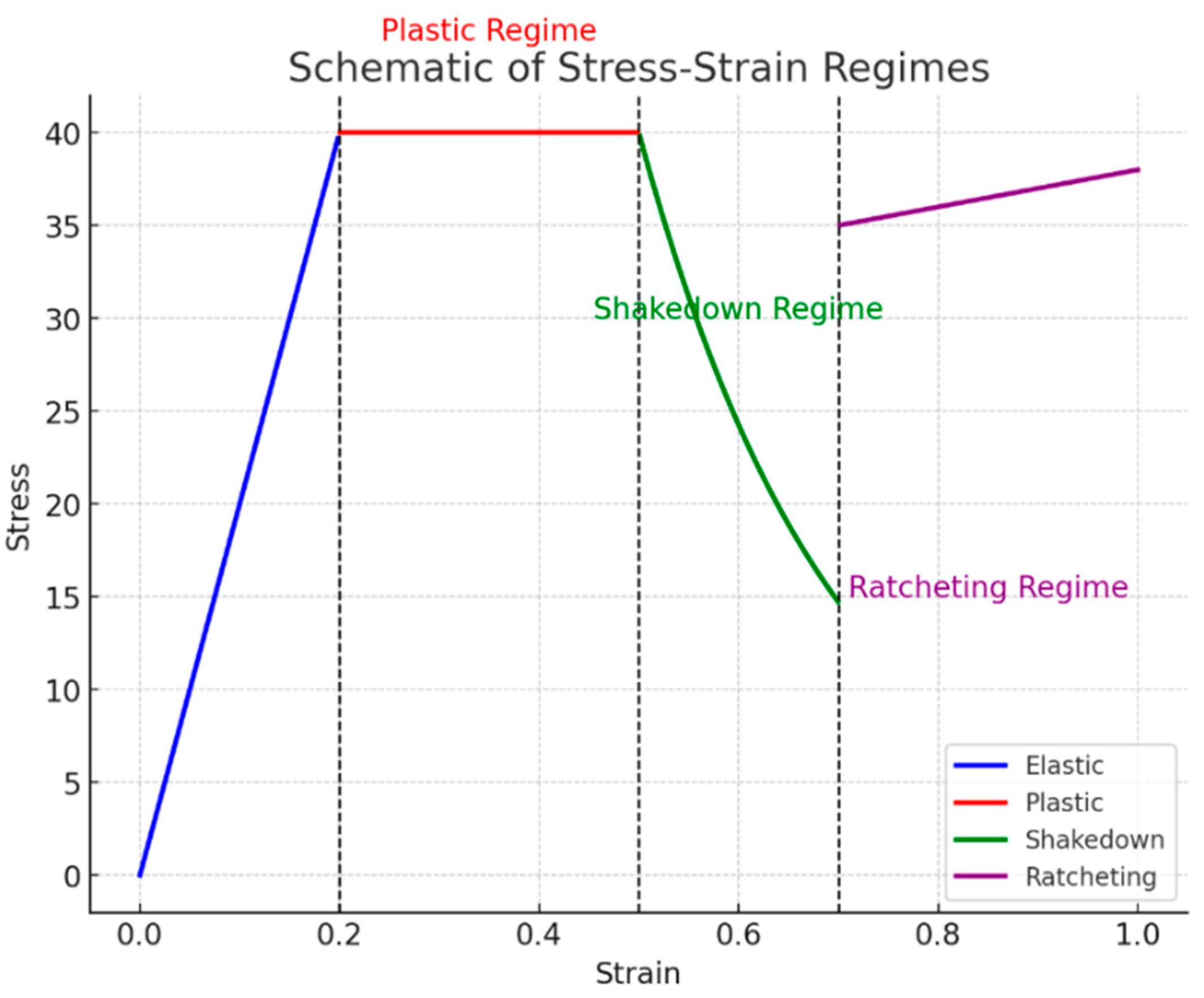

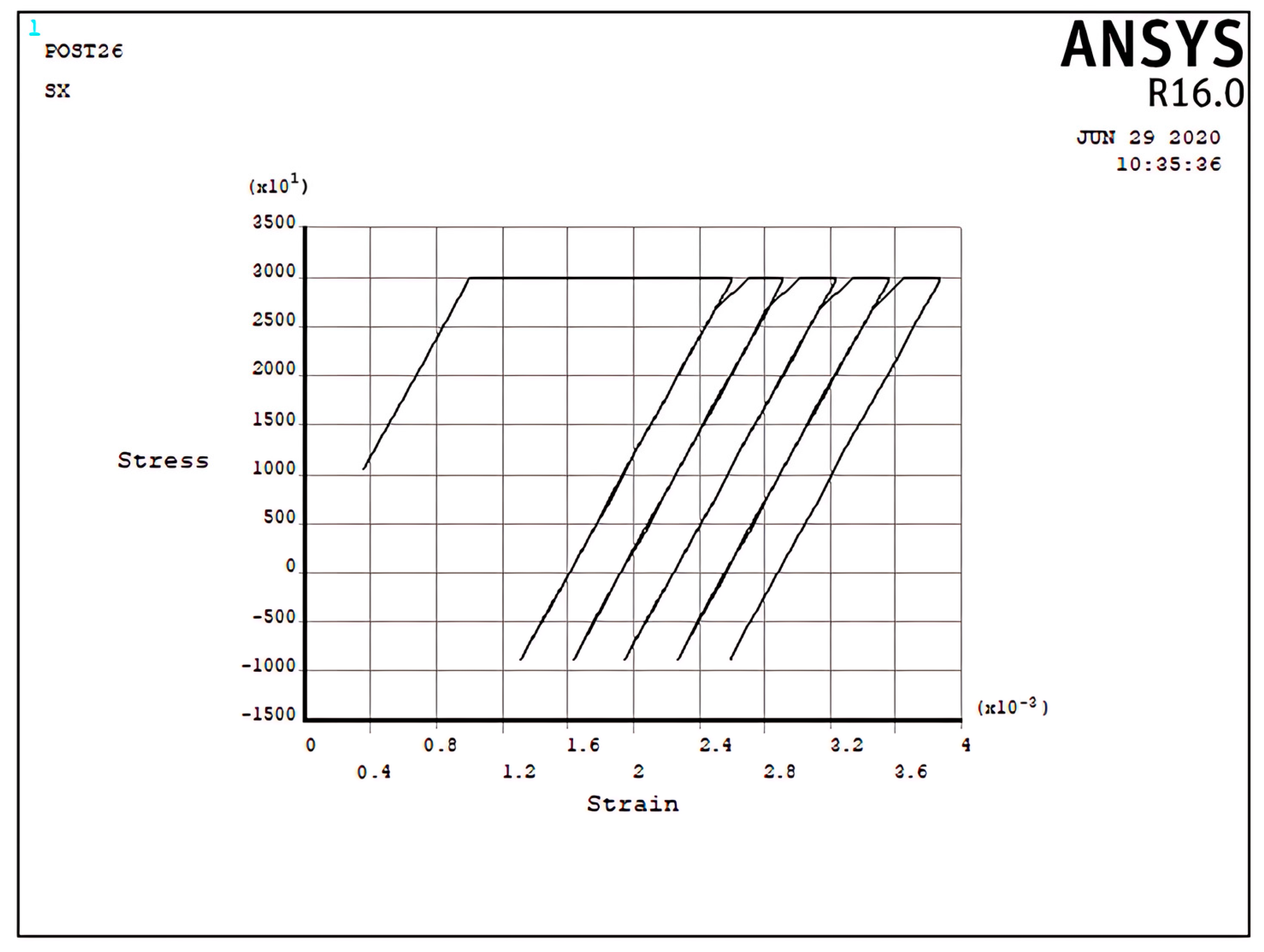
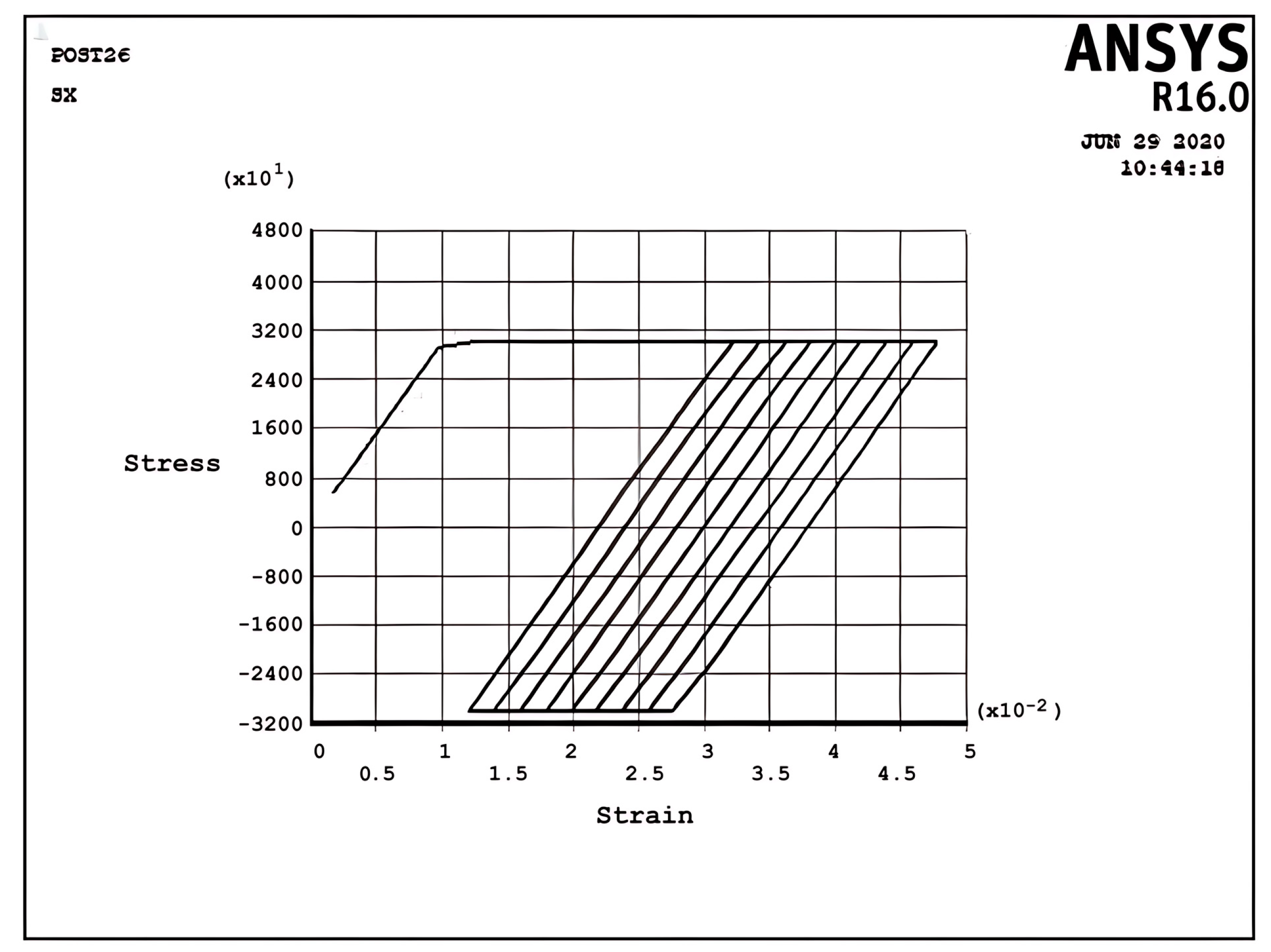




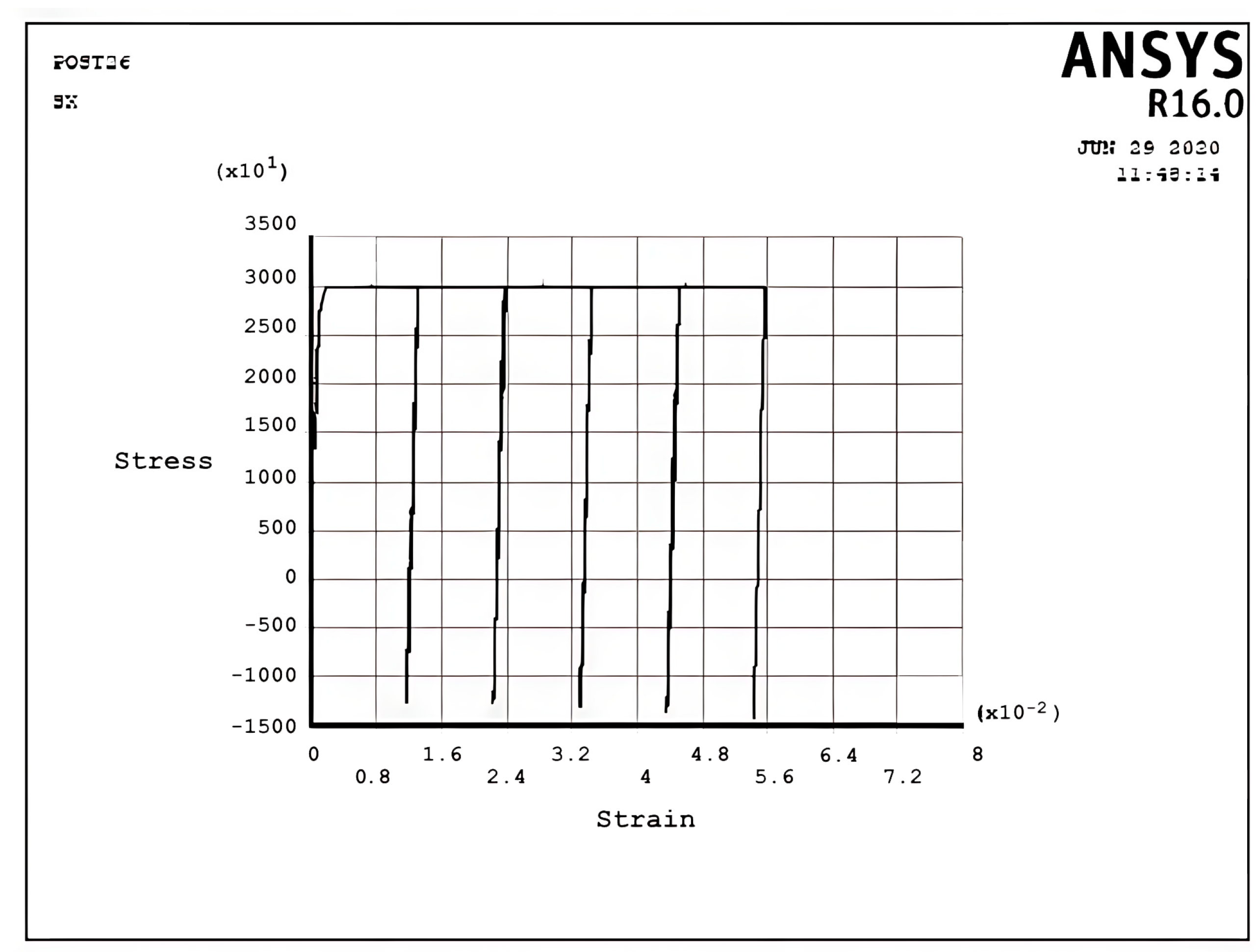
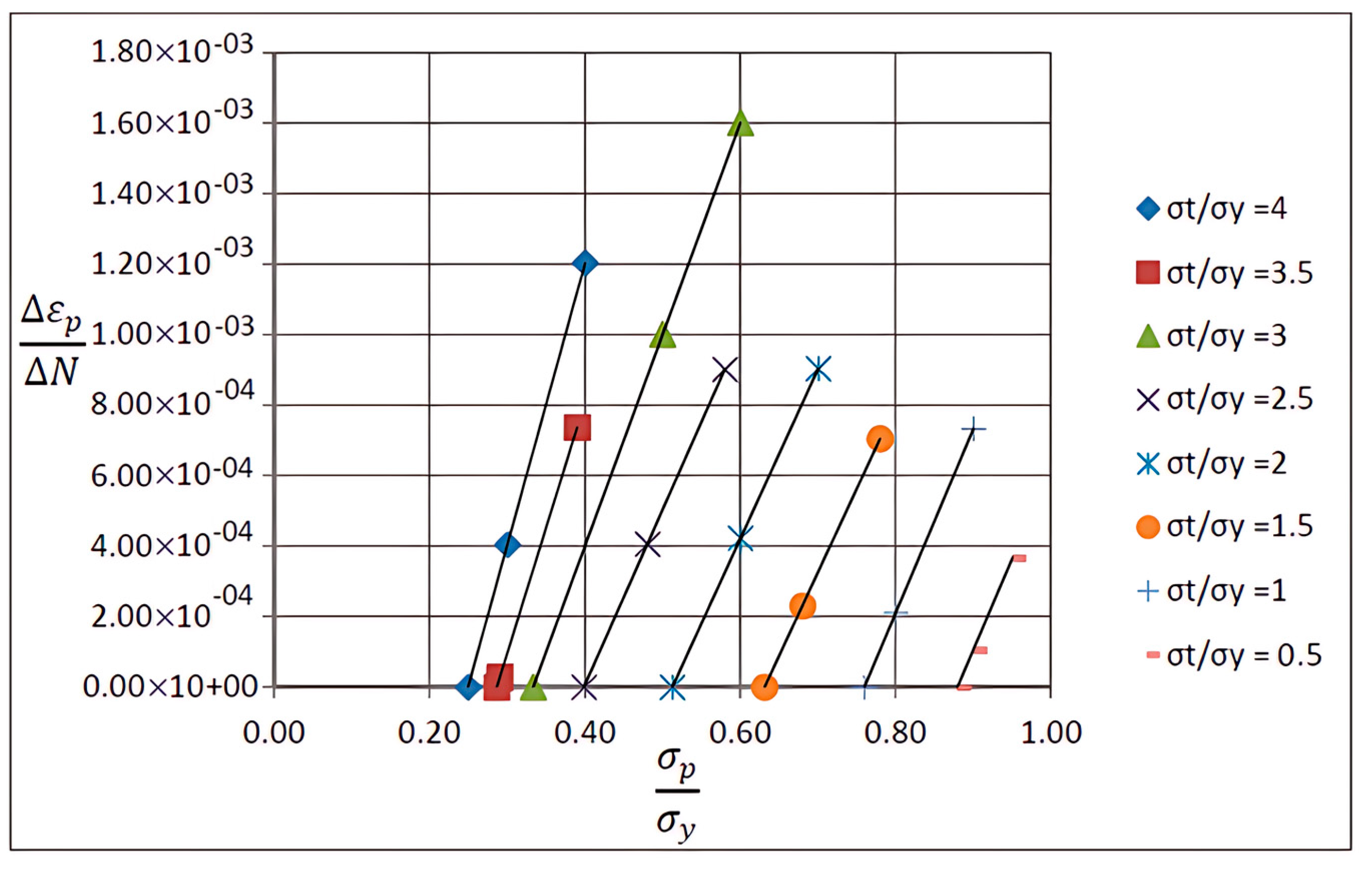
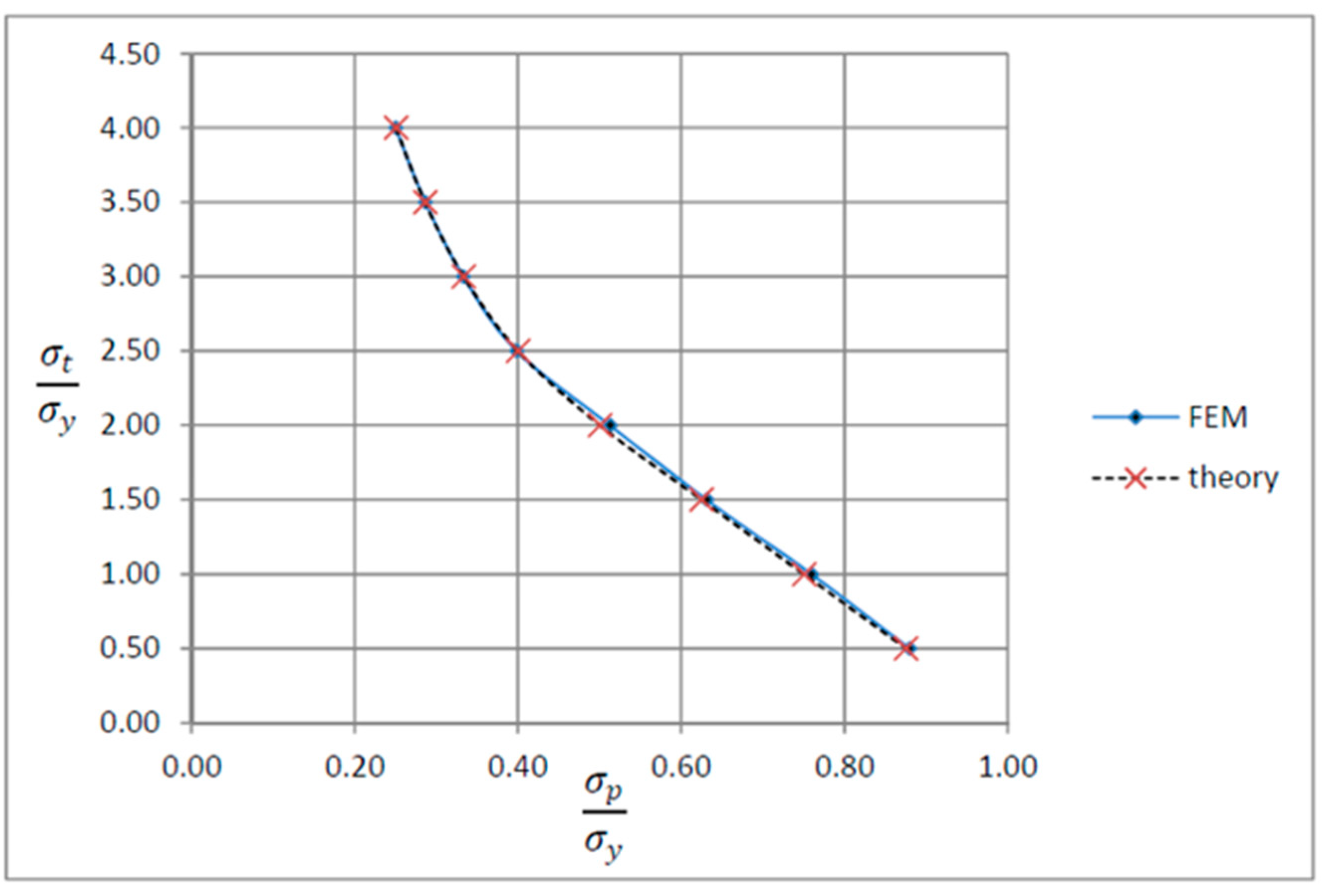
| Reference | Materials Studied | Experimental or Modeled | Main Tools Used | Key Results |
|---|---|---|---|---|
| Bingjun Gao [5] | Low carbon steel | Modeled | C-TDF approach, Jiang–Sehitoglu model | Isolated the shakedown area accurately. |
| Shariati et al. (2012) [6] | Polyacetal | Experimental | Uniaxial cyclic loading | Ratcheting strain sensitive to stress amplitude and mean stress. |
| Zhu et al. (2017) [7] | Metals | Modeled | Fatigue life prediction models | Proposed a highly accurate fatigue life prediction model. |
| Shariati and Kolasangiani (2017) [13] | SS304L cylindrical shells | Experimental | Servo-hydraulic Instron 8802 machine | Plastic deformation increases with cylindrical shell angle. |
| Bree (1967) [30] | Thin tubes | Modeled | Analytical methods | Introduced regimes related to strain behavior under cyclic loads. |
| Servatan et al. (2023) [26] | Al 4043, SS316L, Ti–6Al–4V alloys | Modeled | Finite element analysis (Chaboche’s model) | Close agreement between predicted and simulated ratcheting curves. |
| Yu et al. (2023) [27] | Ti6Al4V alloy (for medical implants) | Experimental and Modeled | Electron beam melting, fatigue life modeling | Mapping ratio significantly affects fatigue properties. |
| Young’s Module | 30 × 106 MPa |
|---|---|
| Thermal conductivity | 0.01 W/mK |
| Coefficient of thermal expansion | |
| Poisson’s ratio | 0.3 |
| Yield stress | 30,000 MPa |
| (Theory) | ||||
|---|---|---|---|---|
| 4 | 0.3 | 0.04048 × 10−2 | 0.24936 | 0.25 |
| 0.4 | 0.12044 × 10−2 | |||
| 3.5 | 0.29 | 2.71 × 10−5 | 0.28618 | 0.28571 |
| 0.39 | 0.07374 × 10−2 | |||
| 3 | 0.5 | 0.10019 × 10−2 | 0.33298 | 0.3333 |
| 0.6 | 0.16017 × 10−2 | |||
| 2.5 | 0.48 | 0.04052 × 10−2 | 0.39841 | 0.4 |
| 0.58 | 0.09018 × 10−2 | |||
| 2 | 0.6 | 0.042242 × 10−2 | 0.51151 | 0.5 |
| 0.7 | 0.09036 × 10−2 | |||
| 1.5 | 0.68 | 0.02308 × 10−2 | 0.63155 | 0.625 |
| 0.78 | 0.07042 × 10−2 | |||
| 1 | 0.8 | 0.02119 × 10−2 | 0.75937 | 0.75 |
| 0.9 | 0.7335 × 10−2 | |||
| 0.5 | 0.9 | 0.10594 × 10−3 | 0.87969 | 0.875 |
Disclaimer/Publisher’s Note: The statements, opinions and data contained in all publications are solely those of the individual author(s) and contributor(s) and not of MDPI and/or the editor(s). MDPI and/or the editor(s) disclaim responsibility for any injury to people or property resulting from any ideas, methods, instructions or products referred to in the content. |
© 2024 by the authors. Licensee MDPI, Basel, Switzerland. This article is an open access article distributed under the terms and conditions of the Creative Commons Attribution (CC BY) license (https://creativecommons.org/licenses/by/4.0/).
Share and Cite
Shahrjerdi, A.; Heydari, H.; Bayat, M.; Shahzamanian, M. Incremental Growth Analysis of a Cantilever Beam under Cyclic Thermal and Axial Loads. Materials 2024, 17, 4550. https://doi.org/10.3390/ma17184550
Shahrjerdi A, Heydari H, Bayat M, Shahzamanian M. Incremental Growth Analysis of a Cantilever Beam under Cyclic Thermal and Axial Loads. Materials. 2024; 17(18):4550. https://doi.org/10.3390/ma17184550
Chicago/Turabian StyleShahrjerdi, Ali, Hamidreza Heydari, Mehdi Bayat, and Mohammadmehdi Shahzamanian. 2024. "Incremental Growth Analysis of a Cantilever Beam under Cyclic Thermal and Axial Loads" Materials 17, no. 18: 4550. https://doi.org/10.3390/ma17184550
APA StyleShahrjerdi, A., Heydari, H., Bayat, M., & Shahzamanian, M. (2024). Incremental Growth Analysis of a Cantilever Beam under Cyclic Thermal and Axial Loads. Materials, 17(18), 4550. https://doi.org/10.3390/ma17184550






